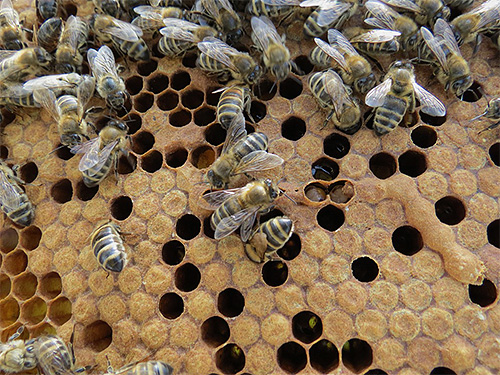
For most people, the bee moth is known only for the fact that on the basis of its larvae a tincture is prepared, which is used in the fight against tuberculosis and some other diseases. This butterfly is also called a wax moth, and its main feature is that its larvae feed in bee hives not only on honey and bee bread, but also on wax (due to a special enzyme), seriously harming honey production and causing indignation among beekeepers.
However, despite the popularity and widespread use of bee moth tincture, in fact there is no scientific evidence and justification for its effectiveness. Moreover, many tend to consider it a placebo remedy - relieving diseases only because of the person's belief that "the tincture works."
So is there any positive effect from using the tincture? Let's look at this issue in more detail.
Bee moth: description, appearance, lifestyle and nutrition
The so-called bee moth, in general, is not similar to the familiar home moth. This is a medium-sized butterfly with a wing length of about 25-35 mm, an unsightly gray-brown color.
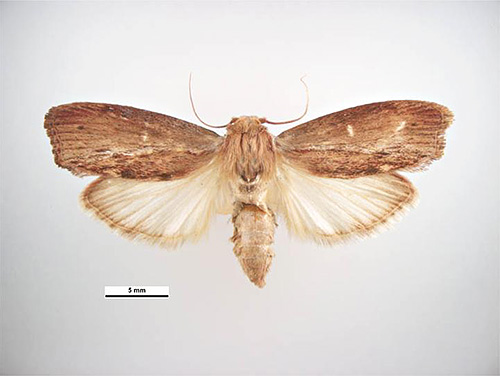
When she sits on any surface, belonging to the family of moths in her gives out the shape of her head and a small peculiar "nose". In general, the coloration of this butterfly is protective and allows it to camouflage itself on the bark of trees.
On a note
The term "bee moth" in science means several types of butterflies, but the people call it the big bee moth. It is her larvae that reach the largest size and are best suited for making tinctures.
The bee moth in its biology is closely related to the bees themselves. Its larvae live in hives and feed on almost all the products that bees produce: honey, wax, bee bread, and even the bee larvae themselves.
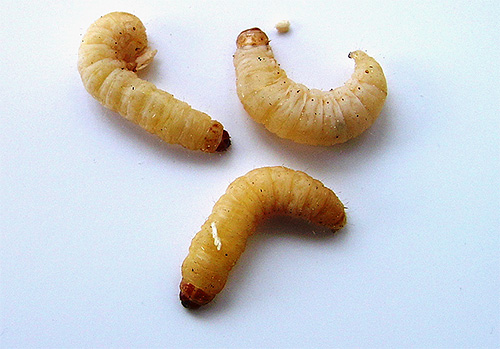
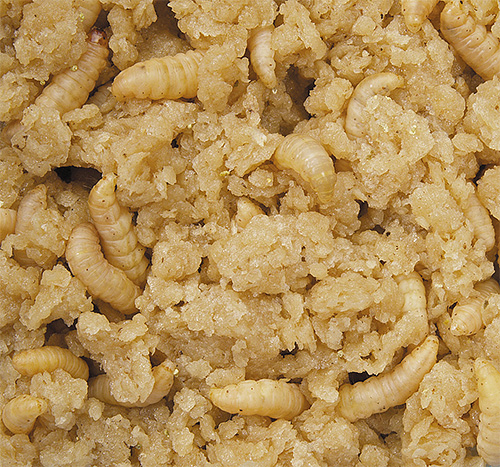
Butterfly moths are bred here, in the hives, but for breeding they leave the nest and mate outside the hive.
It is interesting
Bees do not touch either butterflies or moth larvae due to the fact that they can mask themselves with the help of secreted odorous substances identical to those of the bees themselves. Even despite the fact that outwardly the bee moth butterfly is absolutely nothing like either a bee or its larva, the owners of the hive trust their sense of smell and do not dare to interfere with the life of parasites that “lead them by the nose” in almost the truest sense of the word.
Adult bee moth butterflies do not feed at all and do not live long. They mate already in the first days after emerging from the pupae, and literally in a week the females manage to fulfill their main purpose - to find a new hive of bees and lay eggs in it.
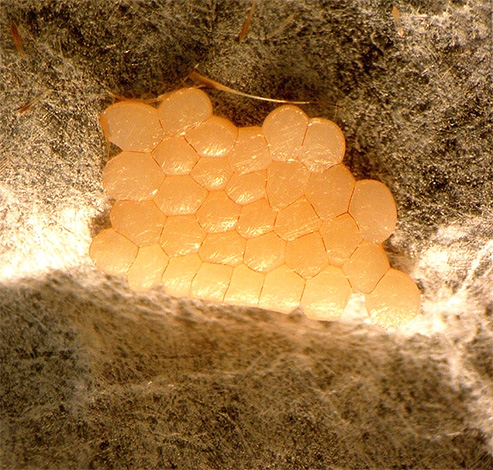
The larvae of the bee moth emerging from the eggs at first feed only on honey, but then they switch to more abundant food - wax. At the same time, they damage the combs, entangle them with silk and prevent the bees from feeding their brood.
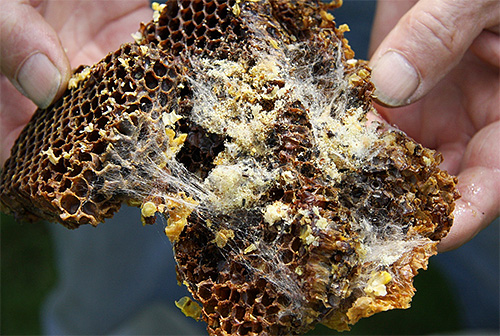
With a serious infection, butterflies can lead to the death of the bee colony. That is why wax moth is considered one of the most dangerous parasites in beekeeping.
On a note
If the hive is heavily infested, the moth larvae can exhibit cannibalism or eat various organic remains, bee larvae, and even insulating debris in the hive.
It is extremely difficult to fight the wax moth, and for beekeepers the appearance of this butterfly in the hives is a big headache.
There is an opinion that at one time enterprising beekeepers decided to somehow make money from their misfortune and came up with healing properties in wax moth larvae. And already popular rumor spread this rumor and turned the bee moth tincture into a real elixir against all diseases.
Indications and method of application of tincture
The wax moth has found its application in the folk treatment of a huge number of diseases.
Initially, it was used to treat tuberculosis, since the effectiveness of the remedy was justified by the presence in the digestive tract of moth larvae of a special enzyme called cerrase, which equally successfully breaks down both the wax in the bee hive and the phospholipid shells of Koch's bacillus, the main causative agent of tuberculosis.
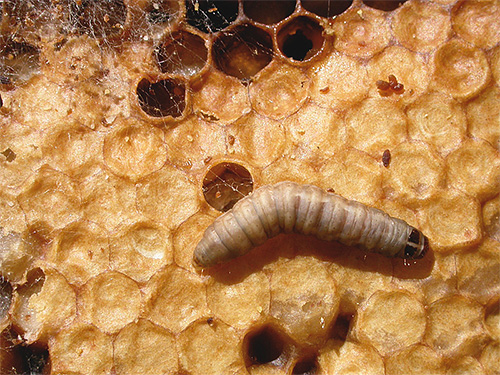
However, over time, folk healers began to prescribe a tincture of bee moth for the treatment of diseases so different that today this remedy has gained fame as a real panacea - it is advised to use it for almost everything.
So, for example, bee moth is prescribed for the treatment of diseases of the lungs, cardiovascular and genitourinary systems, nervous disorders, allergies, diseases of the gastrointestinal tract, and oncological diseases.It is only important to take into account that official medicine does not recognize this remedy, and certified doctors never prescribe the tincture of bee moth with all its “healing” properties.
On a note
For the sake of truth, it is worth noting that there is no statistically significant evidence of the effectiveness of the bee moth in the fight for health. The “cerrase” enzyme, to which the defenders of the drug appeal, does not exist in official biochemistry, and scientific research on the tincture was carried out by only one person who is not known to anyone except the sellers of the tincture.
Bee moth tincture is produced by private beekeepers in the form of a 10% and 20% solution (“extract”).
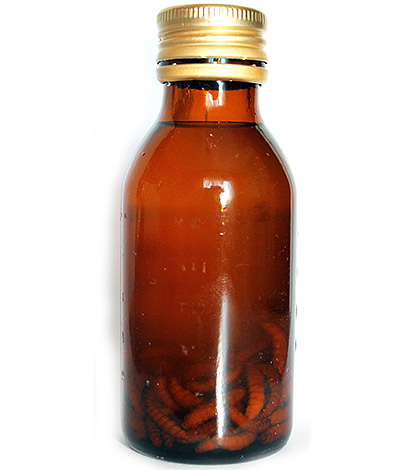
Use them at the rate of 2-3 drops per 10 kg of human weight three times a day. The required amount of tincture for use is dissolved in any liquid.
Review
“When chest pains and coughing became constant, I went for an examination. According to the results of the X-ray - tuberculosis, a pathology in the upper part of the right lung. I left the hospital, I didn’t even buy a mountain of medicines, I immediately ordered a bee moth. I drank a teaspoon twice a day. Two months later, on x-rays, the area of the lung lesion was two times smaller. So I'll be cured."
Oleg, Kirov
Healers themselves prescribe certain amounts of tincture for treatment in accordance with a particular case. For those who really care about their health, it is advisable to talk with a doctor who has successful experience in treating a particular disease before purchasing and using the product.
Preparation of tincture of bee moth
The bee moth tincture is prepared quite simply: the required number of larvae is poured with 40% alcohol in a ratio of 1:10 for a 10% solution or 1:5 for a 20% solution.
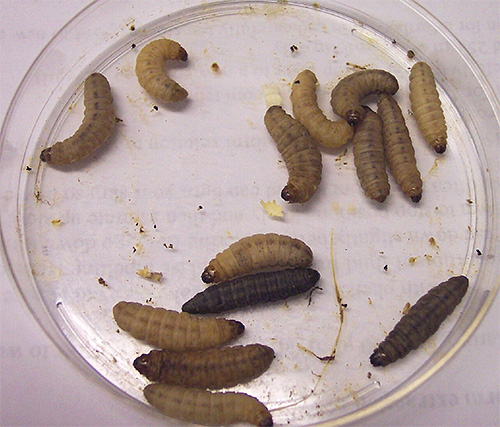

To prepare the infusion, larvae about 15 mm long, of the penultimate or last instar, are selected. These caterpillars already have a sufficient amount of useful substances in their body: they constantly produce the cerrase enzyme, since they are still actively feeding.
On a note
The wrong name for the tincture is bee moth extract. The extract is usually obtained by heating highly crushed raw materials, while the larvae of the moth are immersed in alcohol unharmed and even alive. For the remedy to be called an extract, the larvae would have to be dried and ground before being alcoholized.
Contraindications and side effects
There are few contraindications to the use of bee moth tincture. It is not recommended to drink it:
- children under 14
- pregnant and lactating women
- people with acute forms of inflammatory diseases of the gastrointestinal tract.
In general, side effects from the use of tincture are usually not observed. Very rarely, it can cause allergic reactions in particularly sensitive patients.
Where and how to buy bee moth tincture
You can buy bee moth tincture only from private beekeepers-manufacturers. The tincture is usually sold via the Internet, and the price of a 100-ml bottle with a 20% solution is usually 700-800 rubles.
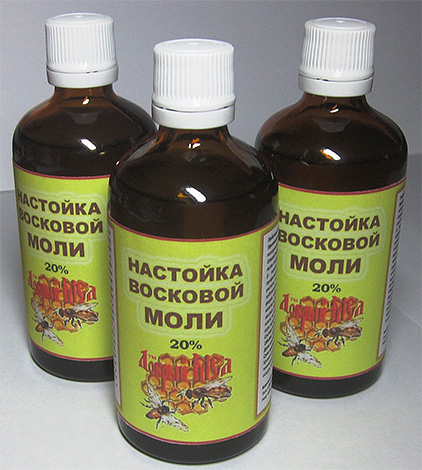
Usually, suppliers offer to buy wax moth in the form of still living larvae for self-preparation of tinctures. This is not the best option, simply because once outside the hive, the caterpillars at any stage begin to pupate, and they will not make a good medicine.Therefore, you need to purchase a mole only when it can be poured with alcohol for several hours.
And finally: before using the tincture of bee moth, you should always consult with your doctor. Placing high hopes on this remedy, you can miss the moment favorable for treatment and start a serious illness.
Be healthy!

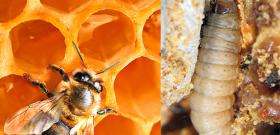

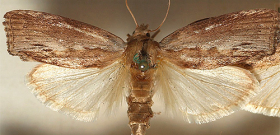
She drank wax moth tincture for the prevention of tuberculosis, as she was in contact with the patient. I noticed that varicose veins became much less visible on my legs and leg cramps stopped. At the same time, papillomas on the body and all “age-related” skin changes began to disappear. So the tincture does its job, no matter what the doctors say. Try everyone who has similar sores and see for yourself. I wish you health.
And I found a health-improving course of 20% wax moth extract Galleria mellonella 350 ml - these are 5 bottles of 70 ml each, it costs only 1100 rubles. Ognevka from Bashkiria from a beekeeper in the 4th generation.
Two years ago I fell ill with bilateral pneumonia, which took place in a severe form. My friend from St. Petersburg, a generalist beekeeper, sent me a wax moth tincture in Simferopol. I am still in a rather bad condition, I asked to be discharged from the hospital home and began to drink this tincture one tsp. for 0.5 cups of water. A month later, computed tomography showed excellent changes in the lungs. It turns out that my alveoli were covered with fibrous tissue, this is very dangerous for the lungs, a person can eventually suffocate. I continued to drink this tincture and here is a VICTORY, these fibrous growths completely disappeared from me, I breathe easily. And to my friend, Lena, I am very grateful for her advice and for this tincture.
How can moths heal? I don't understand and I don't think it's true.
Hello! Can the thyroid be cured?
Even hemorrhoids can be cured!